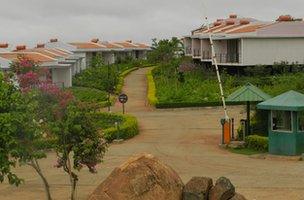Why India's elderly are moving to retirement homes
- Published
Many of India's affluent elderly are moving to retirement villages
When KS Shekar's sons decided to settle down abroad, they invited him to come and live with them.
But Mr Shekar had other plans.
He moved into a comfortable 30-acre, 200-cottage "retirement village" on the outskirts of India's southern city of Bangalore, well-known as the country's info-tech capital.
"I wanted to live my retirement phase on my own terms and I have no qualms about it. My wife and I love to read and write, we enjoy nature and love to mix with like-minded people. If we were staying with the children, our lives would be governed by their will. This is not on," he says.
At their plush retirement cottage, flanked by artificial lakes and with a view of surrounding hills, the couple keep in touch with their children over Skype.
Changing times
"When my parents decided to stay away from us, the feeling of guilt did creep in. But now I'm glad to see them independent and happy," Kishore Shekar, who is a doctor in Glasgow, says.
"My brother and I would never want to take that away from them."
Traditionally, children in India have looked after their parents in their twilight years.

Most elderly in India expect to be dependent on their children
"Unlike in the West where the elderly dread the thought of being dependent on their children, the elderly in India expect to be dependent on their children. Eyebrows are raised if this equation is not seen in a family," says sociologist Patricia Uberoi.
But times are slowly changing.
Mr Shekar and his wife are a part of the growing number of elderly people who are breaking away from the traditional family system and staying away from their children, mostly out of choice.
This, in turn, has spurred demand for retirement homes that now dot the outskirts of the main cities.
Mr Shekar's upscale retirement "village" has emergency medical services, wheelchairs, a health club, anti-skid flooring and elderly-friendly bathrooms and a community kitchen. Residents include retired teachers, engineers, doctors and company executives.
'Huge market'
"India today has 100 million elderly people. If you take 5% of them as the middle class, it comes to five million people. It is a huge number and there's hardly any availability of old-age homes. So there's a huge market out there for realtors," says A Sridharan, chief of Covai Senior Care Constructions that builds retirement homes.

Retirement homes have become popular among the affluent elderly
Mr Sridharan believes the migration of the elderly to retirement homes - which can cost anywhere between $14,000 (£9,333) and $150,000 (£100,000) - began with the info-tech boom in the 1990s.
"A lot of young middle-class Indians left the country during the boom. Their children don't want to be known as people who have their parents living in old age homes. So a need for such exclusive homes was felt and the rising middle-class is securing its retirement years by buying exclusive homes."
Mr Shekar says he chose to live in a retirement home because of "happiness that I share with my wife and friends here".
"We are a set of like-minded people and love to share jokes and our life experiences. That's why I chose this life."
- Published3 May 2011
- Published25 January 2011